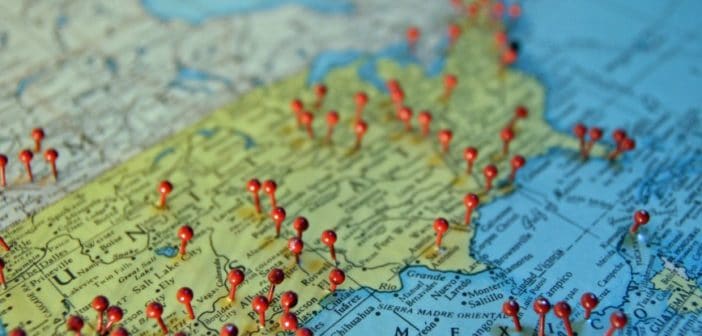 Apparently cheddar cheese has nothing on IPAs. Wisconsin is home to some of the country’s “drunkest cities,” according to the results of a study conducted by financial news website 24/7 Wall Street. Their special report examined county-level health data across the US. The authors “figured out which cities had the highest percentage of residents who admitted to regular binge or heavy drinking, then ranked them.” The website also factored in household incomes, premature death rates and the percentage of driving deaths caused by alcohol. Overall, Wisconsin has the dubious honor of landing 12 cities in the Top 20.
Apparently cheddar cheese has nothing on IPAs. Wisconsin is home to some of the country’s “drunkest cities,” according to the results of a study conducted by financial news website 24/7 Wall Street. Their special report examined county-level health data across the US. The authors “figured out which cities had the highest percentage of residents who admitted to regular binge or heavy drinking, then ranked them.” The website also factored in household incomes, premature death rates and the percentage of driving deaths caused by alcohol. Overall, Wisconsin has the dubious honor of landing 12 cities in the Top 20.
Mapping It Out
I remember when I could mentally segment a map of the US into nostalgic drinking zones: New England for its underground brick bars, the Pacific Northwest for its microbreweries, the desert Southwest for its thatch-roofed taquerias. Looking at a map of the country’s drinking habits, it seems so quaint, cartoonish and misguided to me now. The 24/7 Wall Street study analyzed the self-reported drinking habits and behaviors from 381 metro areas across the country, ranking those results into both the “drunkest” and the “driest” cities.
Appleton, Wisconsin topped the list with a lightheaded 26.8% of its residents regularly drinking excessive amounts of alcohol. “We’ve known for a long time both in Wisconsin and in Appleton that we have a culture of alcohol,” Appleton’s public health director said. “I think part of that culture is being honest about reporting too.” While it remains to be seen whether Appleton is simply better at telling on itself when it comes to bingeing and excessive drinking, it’s followed by other Wisconsin cities like Oshkosh-Neenah, Green Bay and Madison, respectively. The health director continued by saying, “I think availability of alcohol, price of alcohol, is a factor as well. In Wisconsin, it’s very inexpensive to purchase and drink alcohol compared to other states.”
How Much is “Too Much”?
The Centers for Disease Control and Prevention includes binge drinking, use by minors under 21, any alcohol use by pregnant women and heavy drinking among its criteria for “excessive alcohol use.” While “heavy drinking” seems pretty broad to me, the CDC puts a finer point on it: “For men, heavy drinking is typically defined as consuming 15 drinks or more per week,” the institute says. “For women, heavy drinking is typically defined as consuming 8 drinks or more per week.”
Excessive drinking doesn’t just contribute to a bad liver—it’s also to blame for bad behavior, like drinking and driving. “Drunk driving accounts for 31.0% of roadway fatalities nationwide,” the 24/7 report says, correlating the highest drinking rates with the deadliest car accidents that involved alcohol. “In Green Bay, Wisconsin, for example, a city where over a quarter of adults drink excessively, 47.5% of fatal car accidents involve alcohol, the seventh highest share in the country.” This statistic is dizzying, but almost makes too much sense, striking me as one of the darkest examples of cause and effect.
The report makes another disturbing corollary: while the CDC finds that alcohol “takes a tremendous $249 billion toll on the economy, [it]can also be a boon for certain local businesses.” In some ways, this is a snake swallowing its tail or, perhaps, the worm swallowing its own tequila. Aside from Corvallis, Oregon, every single city that landed in the Top 20 has “at least 1.6 bars for every 10,000 residents.” The report also noted that there are parts of Wisconsin and Minnesota where that figure is much higher, going as high as 6.9 bars for every 10,000 residents. The opposite is also true: the lowest drinking rates have fewer bars for that same number of residents.
Cost is also figurative when it comes to boozing it up. Binge drinking is more common in households that make an average of $75,000 per year while, interestingly, the cities with the lowest excessive drinking rates tend to be relatively poor. In fact, the report contends that “three-quarters of the cities with the lowest excessive drinking rates have a higher poverty rate than the nation as a whole.” At my alcoholic worst, no amount of money was going to stand between me and a drink. Even without a job, I somehow found the cash for booze. That’s clearly not the case for everyone.
Without a Drop
While the Midwest might be a lightning rod for excessive drinking, it’s worth paying attention to the cities that turn down alcohol. The “driest city” in America is Provo-Orem, Utah, where just 9.2% of adults drink to excess (14.9% driving deaths were linked to alcohol there, too—a square contrast with Appleton’s mind-boggling 30.3%). Other Utah cities that made the “bottom” of the list include St. George, Logan, and Odgen-Clearfield. The report’s authors attribute the state’s small share of drinkers to its large Mormon population (Mormons account for about 60% of Utah). With a religion that expressly forbids alcohol, laws around it are extremely restrictive, limiting the places it can be sold, as well as the use of Zion curtains, which prevent bar patrons from seeing their drinks being prepared. Also, at 251 people, the premature death rate in Provo-Orem is also far lower than the rest of the country. But the state isn’t exempt from sobering stats. The CDC noted that Utah has the seventh-highest rate of alcohol-poisoning deaths.
Many other dry cities were clustered in the South: Tennessee had seven of the driest cities, followed by the likes of Alabama, Mississippi, and Arkansas. The report also lists Beckley, West Virginia as one of the country’s driest cities which is notable because “despite its low rate of alcohol consumption, [it]has the highest rate of premature death in the country.”
While the study pinpoints excessive drinking on a map, it’s important to consider that—in backwaters and bustling downtowns alike—alcohol abuse is everywhere.
Photo courtesy of Marc Levin via Flickr [CC0 (https://creativecommons.org/licenses/by/2.0/)] (resized and cropped)
Sponsored DISCLAIMER: This is a paid advertisement for California Behavioral Health, LLC, a CA licensed substance abuse treatment provider and not a service provided by The Fix. Calls to this number are answered by CBH, free and without obligation to the consumer. No one who answers the call receives a fee based upon the consumer’s choice to enter treatment. For additional info on other treatment providers and options visit www.samhsa.gov.




